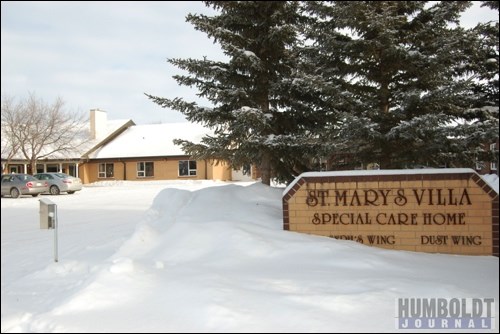Some residents of a long-term care home in Humboldt didn't have a very good Boxing Day.
In the early hours of December 26, 40 residents of St. Mary's Villa (SMV) were evacuated after carbon monoxide from a failed boiler got into the heating vents.
Staff working at the home first suspected carbon monoxide around 3 a.m. when they experienced symptoms of exposure to the gas, including nausea, headaches, dizziness and other flu-like symptoms. Staff called the facility manager who arrived on site and called SaskEnergy. A SaskEnergy employee arrived on site approximately an hour and a half later and confirmed high levels of the gas in the Dust Wing of the facility.
Thirty-nine residents and some staff in that wing were moved to another wing, before 24 residents were transferred to Humboldt District Hospital (HDH) for treatment.
Father Roman Schneider, 89, had long-term health problems and died within minutes of his arrival at the hospital, said Dr. David Poulin, vice-president of medical affairs for the Saskatoon Health Region (SHR).
While a doctor assumed Schneider had died from natural causes, a review of the case by health officials indicated that carbon monoxide poisoning was potentially a contributing factor to the death.
Blood samples were not taken from Schneider at the hospital and the body had already been released to a funeral home when a connection was suspected, Poulin said.
The provincial coroner is investigating the death.
Schneider was born in St. Benedict and was a priest for more than 60 years. He retired to St. Peter's Abbey in Muenster about two years ago and moved into SMV in 2010.
Schneider was the parish priest at Cudworth and coached minor ball for several years.
Another resident of the Villa, a woman in her late 80s, was admitted to hospital for further observation. The woman, who had a pre-existing heart condition, suffered a mild heart attack and remains in hospital, said Kelvin Fisher, Director of Rural Health and Planning for SHR.
The other 14 residents were cared for in an unaffected area of the Villa.
Five employees and two visiting family members were also transferred to HDH for further assessment and treatment.
Residents from the Dust Wing had multiple carboxyhemoglobin tests, which measure the level of carbon monoxide in the blood, done, Fisher noted. Staff and visitors had at least one test done and some had more depending on their levels, he added.
"We did find that everyone showed higher than normal levels," Fisher said.
An initial inspection of the facility revealed a boiler failure, which was repaired before residents were moved back into the facility. The backdraft that sent the gas into the heating vents was caused by a damper that didn't open properly and by a plugged filter that was not properly sealed, explained Anne Neufeld, interim vice-president of finance and administration for SHR.
A complete assessment of the boilers was done on December 30 and some further work was done at that time, Fisher said.
The 1997 boiler had been tagged for replacement in 2007, and is on the list of capital improvements being planned for the 2011-2012 fiscal year.
"This will be a priority for us," Fisher said.
The air quality at SMV was monitored throughout the day and residents returned to the Dust Wing during the evening of December 26.
There were no carbon monoxide detectors in the facility at the time of the incident, although several were installed shortly afterwards. The SHR is reviewing the need for carbon monoxide detectors in health care facilities and is working with the province on an implementation plan for all health care facilities.
The residents were moved from the Villa to the hospital with the assistance of the Humboldt and District Ambulance Service and the Humboldt Fire Department.
According to paramedic Derek Dagenais, HDAS supervisor, they responded to SMV at 6:11 a.m. with two ambulances, the City of Humboldt Medi-van, and St. Mary's Villa bus. The crews initially transported 14 patients to the hospital, before 10 additional patients were brought to the hospital for assessment and treatment. Additional staff was brought in to help with the return transfer of all patients to the Villa, he noted.
The staff did a great job and handled a difficult situation very well, Dagenais said.
"We don't deal with Mass Casualty Incidents (MCI) on a regular basis, but they put their triage and MCI training into effect and followed local policies in respect to dealing with large numbers of patients," he stated. "Our pre-set plans of accessing the city bus, as well as the St. Mary's Villa bus and the mock disaster that we participated in at SMV this past June was very helpful to the situation."
The Humboldt fire department, Emergency Measures Organization (EMO), and the emergency medical services staff did a great job in a critical situation, Dagenais added.
Fisher also praised the work of everyone involved in the incident.
"I'm very pleased with the response under difficult circumstances," Fisher said. "I can't say enough about the ambulance and fire department personnel."
Extra staff was called in to both St. Mary's Villa and the HDH, including nurses, physicians, and lab techs, and spiritual aides, Fisher said.
"Everyone did a phenomenal job," Fisher stated.




